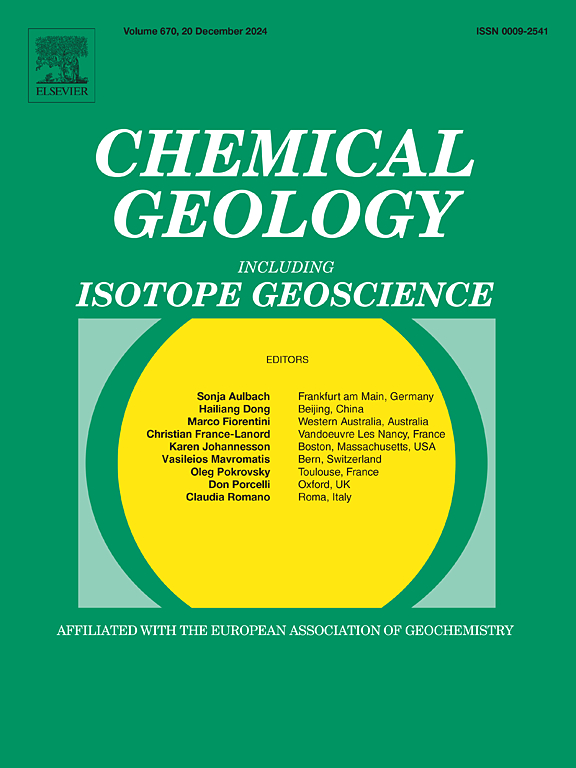Radiation-enhanced fluid diffusion and alteration around uraniferous inclusions in Cenomanian resinite from North Bohemia
IF 3.6
2区 地球科学
Q1 GEOCHEMISTRY & GEOPHYSICS
引用次数: 0
Abstract
Advanced analytical methods including SEM/EDX and μ-PIXE/RBS microanalyses were used to investigate chemical alterations around uraniferous inclusions in a Cenomanian fossil resin (resinite). Studied alterations related to several types of discontinuities in resinite matrix are a model example of the phase interface between solid polymeric hydrocarbon and aqueous fluids exposed to long-term irradiation by heavy energetic ions resulting mostly from the natural decay of uranium. Computational models of ion ranges correspond well with the observed range of alterations about 35 μm from uraniferous inclusions. The major alteration is found within a 20 μm inner zone. It is characterized by distinct sulfur enrichment and an increase in the O/C ratio. No sulfur enrichment in the resinite matrix occurs apart from the uraniferous phases. Proton beam-induced alterations of the resinite were investigated and compared with the natural ones. The differences indicate the importance of aqueous fluids in the natural radiation-induced alteration process. It is concluded that radiation-enhanced mass transfer and reactions occur at solid-fluid interfaces during the long-term energy deposition by alphas, alpha recoils, and fission fragments combined. The role of thermal effects and and formation of radical species by radiolysis of aqueous fluids on a microscale is discussed.
北波西米亚塞诺曼尼亚树脂岩含铀包裹体周围的辐射增强流体扩散和蚀变
采用SEM/EDX和μ-PIXE/RBS微量分析等先进分析方法,研究了一种Cenomanian树脂化石(树脂岩)中含铀包裹体的化学变化。所研究的树脂岩基质中几种类型不连续的变化是固体聚合烃和含水流体长期暴露于主要由铀自然衰变引起的重能离子照射下相界面的一个典型例子。离子范围的计算模型与观测到的含铀包裹体约35 μm的变化范围吻合较好。蚀变主要发生在20 μm内。其特征是硫富集明显,O/C比值增大。除含铀相外,树脂岩基体中无硫富集。研究了质子束诱导树脂体的变化,并与天然树脂体进行了比较。这些差异表明了含水流体在自然辐射蚀变过程中的重要性。结果表明,在α、α反冲和裂变碎片的长期能量沉积过程中,固体-流体界面发生了辐射增强的传质和反应。本文讨论了热效应的作用和微尺度辐射分解水溶液中自由基的形成。
本文章由计算机程序翻译,如有差异,请以英文原文为准。
求助全文
约1分钟内获得全文
求助全文
来源期刊

Chemical Geology
地学-地球化学与地球物理
CiteScore
7.20
自引率
10.30%
发文量
374
审稿时长
3.6 months
期刊介绍:
Chemical Geology is an international journal that publishes original research papers on isotopic and elemental geochemistry, geochronology and cosmochemistry.
The Journal focuses on chemical processes in igneous, metamorphic, and sedimentary petrology, low- and high-temperature aqueous solutions, biogeochemistry, the environment and cosmochemistry.
Papers that are field, experimentally, or computationally based are appropriate if they are of broad international interest. The Journal generally does not publish papers that are primarily of regional or local interest, or which are primarily focused on remediation and applied geochemistry.
The Journal also welcomes innovative papers dealing with significant analytical advances that are of wide interest in the community and extend significantly beyond the scope of what would be included in the methods section of a standard research paper.
 求助内容:
求助内容: 应助结果提醒方式:
应助结果提醒方式:


